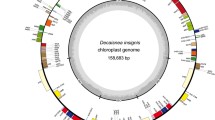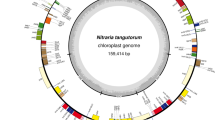Abstract
Microsatellites, or simple sequence repeats (SSRs), contain repetitive DNA sequence where tandem repeats of one to six base pairs are present number of times. Chloroplast genome sequences have been shown to possess extensive variations in the length, number and distribution of SSRs. However, a comparative analysis of chloroplast microsatellites is not available. Considering their potential importance in generating genomic diversity, we have systematically analysed the abundance and distribution of simple and compound microsatellites in 164 sequenced chloroplast genomes from wide range of plants. The key findings of these studies are (1) a large number of mononucleotide repeats as compared to SSR2–6(di-, tri-, tetra-, penta-, hexanucleotide repeats) are present in all chloroplast genomes investigated, (2) lower plants such as algae show wide variation in relative abundance, density and distribution of microsatellite repeats as compared to flowering plants, (3) longer SSRs are excluded from coding regions of most chloroplast genomes, (4) GC content has a weak influence on number, relative abundance and relative density of mononucleotide as well as SSR2–6. However, GC content strongly showed negative correlation with relative density (R 2 = 0.5, P < 0.05) and relative abundance (R 2 = 0.6, P < 0.05) of cSSRs. In summary, our comparative studies of chloroplast genomes illustrate the variable distribution of microsatellites and revealed that chloroplast genome of smaller plants possesses relatively more genomic diversity compared to higher plants.



Similar content being viewed by others
References
Arguello-Astorga GR, Herrera-Estrella LR (1996) Ancestral multipartite units in light-responsive plant promoters have structural features correlating with specific phototransduction pathways. Plant Physiol 112:1151–1166
Bevilacqua A, Fiorenza MT, Mangia F (2000) A developmentally regulated GAGA box-binding factor and Sp1 are required for transcription of the hsp70.1 gene at the onset of mouse zygotic genome activation. Development 127:1541–1551
Busturia A, Lloyd A, Bejarano F, Zavortink M, Xin H, Sakonju S (2001) The MCP silencer of the Drosophila Abd-B gene requires both pleiohomeotic and GAGA factor for the maintenance of repression. Development 128:2163–2173
Ceplitis A, Su Y, Lascoux M (2005) Bayesian inference of evolutionary history from chloroplast microsatellites in the cosmopolitan weed Capsella bursa-pastoris (Brassicaceae). Mol Ecol 14:4221–4233
Chen M, Tan Z, Jiang J, Li M, Chen H, Shen G, Yu R (2009) Similar distribution of simple sequence repeats in diverse completed human immunodeficiency virus type 1 genomes. FEBS Lett 583:2959–2963
Chen M, Tan Z, Zeng G, Zhuotong Z (2012) Differential distribution of compound microsatellites in various human immunodeficiency virus type 1 complete genomes. Infect Genet Evol 12:1452–1457
De wachter R (1981) The number of repeats expected in random nucleic acid sequences and found in genes. J Theor Biol 91:71–98
Dieringer D, Schlotterer C (2003) Two distinct modes of microsatellite mutation processes: evidence from the complete genomic sequences of nine species. Genome Res 13:2242–2251
Dybvig K, Voelker LL (1996) Molecular biology of mycoplasmas. Annu Rev Microbiol 50:25–57
Ebert D, Peakall R (2009) A new set of universal de novo sequencing primers for extensive coverage of noncoding chloroplast DNA: new opportunities for phylogenetic studies and cpSSR discovery. Mol Ecol Resour 9:777–783
Ellegren H (2004) Microsatellites: simple sequences with complex evolution. Nat Rev Genet 5:435–445
George B, Mashhood AC, Jain SK, Sharfuddin C, Chakraborty S (2012) Differential distribution and occurrence of simple sequence repeats in diverse geminivirus genomes. Virus Genes 45:556–566
George B, Gnanasekaran P, Jain SK, Chakraborty S (2014) Genome wide survey and analysis of small repetitive sequences in caulimoviruses. Infect Genet Evol 27:15–24
Gur-Arie R, Cohen CJ, Eitan Y (2000) Simple sequence repeats in Escherichia coli: abundance, distribution, composition, and polymorphism. Genome Res 10:62–71
Hirao T, Watanabe A, Miyamoto N, Takata K (2009) Development and characterization of chloroplast microsatellite markers for Cryptomeria japonica D. Don. Mol Ecol Resour 9:122–124
Jakobsson M, Säll T, Lind-Halldén C, Halldén C (2007) Evolution of chloroplast mononucleotide microsatellites in Arabidopsis thaliana. Theor Appl Genet 114:223–235
Kofler R, Schlotterer C, Luschutzky E, Lelley T (2008) Survey of microsatellite clustering in eight fully sequenced species sheds light on the origin of compound microsatellites. BMC Genomics 9:612
Levinson G, Gutman GA (1987) Slipped-strand mispairing: a major mechanism for DNA sequence evolution. Mol Biol Evol 4:203–221
Li YC, Korol AB, Fahima T, Nevo E (2004) Microsatellites within genes: structure, function, and evolution. Mol Biol Evol 21:991–1007
Metzgar D, Bytof J, Wills C (2000) Selection against frame shift mutations limits microsatellite expansion in coding DNA. Genome Res 10:72–80
Mrazek J (2006) Analysis of distribution indicates diverse functions of simple sequence repeats in Mycoplasma genomes. Mol Biol Evol 23:1370–1385
Mudunuri SB, Nagarajaram HA (2007) IMEx: imperfect microsatellite extractor. Bioinformatics 23:1181–1187
Provan J, Corbett G, McNicol JW, Powell W (1997) Chloroplast DNA variability in wild and cultivated rice (Oryza spp.) revealed by polymorphic chloroplast simple sequence repeats. Genome 40:104–110
Sangwan I, Brian MRO (2002) Identification of a soybean protein that interacts with GAGA element dinucleotide repeat DNA. Plant Physiol 129:1788–1794
Sonah H, Deshmukh RK, Sharma A, Singh VP, Gupta DK (2011) Genome-wide distribution and organization of microsatellites in plants: an insight into marker development in Brachypodium. PLoS One 6(6):e21298. doi:10.1371/journal.pone.0021298
Temnykh S, DeClerck G, Lukashova A, Lipovich L, Cartinhour S, McCouch S (2001) Computational and experimental analysis of microsatellites in rice (Oryza sativa L.): frequency, length variation, transposon associations, and genetic marker potential. Genome Res 11:1441–1452
Toth G, Gáspári Z, Jurka J (2000) Microsatellites in different eukaryotic genomes: survey and analysis. Genome Res 10:967–981
Van Belkum A (1999) The role of short sequence repeats in epidemiologic typing. Curr Opin Microbiol 2:306–311
Van Belkum A, Scherer S, van Alphen L, Verbrugh H (1998) Short-sequence DNA repeats in prokaryotic genomes. Microbiol Mol Biol Rev 62:275–293
Wells R (1996) Molecular basis of genetic instability of triplet repeats. J Biol Chem 271:2875–2878
Wernegreen JJ (2002) Genome evolution in bacterial endosymbionts of insects. Nat Rev Genet 3:850–861
Yeramian E, Buc H (1999) Tandem repeats in complete bacterial genome sequences: sequence and structural analyses for comparative studies. Res Microbiol 150:745–754
Zhang X, Korpelainen H, Li C (2006) Microsatellite variation of Quercus aquifolioides populations at varying altitudes in the Wolong natural reserve of China. Silva Fenn 40:407–415
Acknowledgments
We acknowledge Blessy software solution and The Science & Engineering Research Board, DST, Government of India for funding support. Authors are thankful to Dr. Girish K Srivastava, Actual: Prof. Colaborador Honorífico, IOBA, University of Valladolid, Spain and Dr. Umesh C.S. Yadav, SLS, CUG for language editing.
Conflict of interest
The authors declare that they have no competing interests.
Author information
Authors and Affiliations
Corresponding authors
Additional information
Communicated by M. Kupiec.
Electronic supplementary material
Below is the link to the electronic supplementary material.
Rights and permissions
About this article
Cite this article
George, B., Bhatt, B.S., Awasthi, M. et al. Comparative analysis of microsatellites in chloroplast genomes of lower and higher plants. Curr Genet 61, 665–677 (2015). https://doi.org/10.1007/s00294-015-0495-9
Received:
Revised:
Accepted:
Published:
Issue Date:
DOI: https://doi.org/10.1007/s00294-015-0495-9




